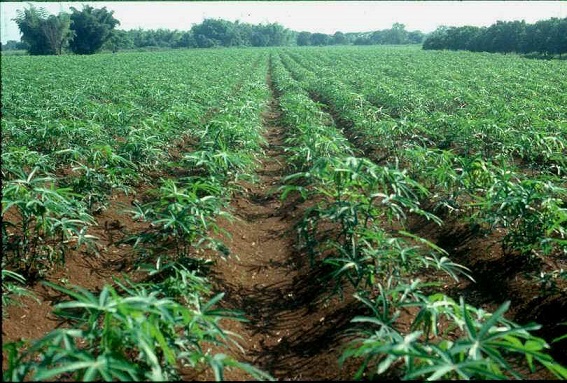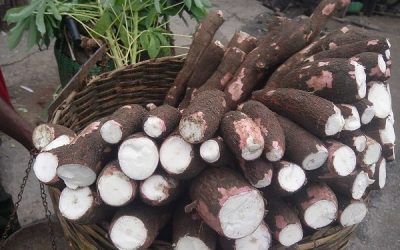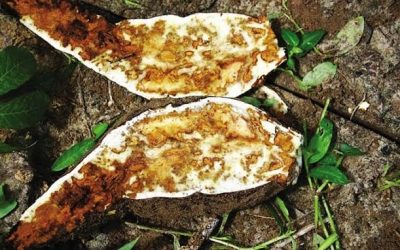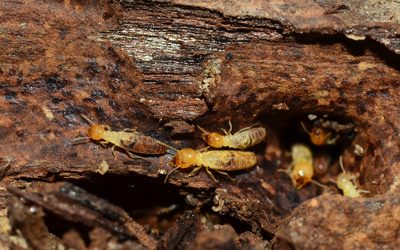
A weed is a plant considered undesirable in a particular situation. Examples commonly are plants unwanted in human-controlled settings, such as farm fields, gardens, lawns, and parks.
Different types of weeds occur in cassava farms and these may cause considerable losses to the farmer.
There are three groups of weeds in a cassava farm namely; grasses, sedges and broadleaf weeds.
Grasses
They are usually slender, erect or creeping plants. They have stems that can be oval or cylindrical in shape. The leaves of grasses are longer than broad and they do not subdivide into leaflets. Common grass weeds in cassava farms include speargrass (Imperata cylindrica), bermudagrass (Cynodon dactylon), Guinea grass (Panicum maximum) and the Feathery Pennisetum (Pennisetum polystachion).
Sedges
Sedges are like grasses but they are usually erect and have solid and triangular shapes stems. The common sedges in cassava farms are Mariscus alternifolius and purple nutsedge (Cyperus rotundus).
Broadleaf weeds
Broadleaf weeds are herbs, creepers, climbers and shrubs with solid stems and are irregular in shape. Their leaves are broad, expanded and single or subdivided into leaflets to form compound leaves. Broadleaf weeds commonly found in cassava farms are Siam weed (Chromolaena odorata), wild poinsetta (Euphorbia heterophylla), giant sensitive weed (Mimosa invisa), tridax (Tridax procumbens), goat weed (Ageratum conyzoides), waterleaf (Talinum traingulare) and tropical spiderwort (Commelina benghalensis).
How do these weeds spread?
After clearing an area for farming weeds are among the first plant the will start appearing on the land, especially when the land is left bare. They grow and reproduce very quickly.
Weeds reproduce and spread through seeds and vegetative structures, eg., rhizomes, stolons, tubers and stem/root basal stocks.
Spread by seeds
Weeds which live for one year (annual weeds) reproduce and spread mainly by seeds. Examples are Sima weeds, wild ponsettia, tridax and goat weed. They shed their seeds mostly in the dry season and die soon afterwards. The seeds survive in the soil and germinate the following season. Also, they can remain the soil for many years until disturbed when the soil is tilled for planting.
To effectively control these weeds, remove them before they start flowering. This will prevent seeding to increase the number of seeds in the soil.
Spread by rhizome
Rhizomes are underground stems running horizontally to the soil surface. They have thin brown papery leaves wrapped around the stem. The rhizomes have roots. Speargrass reproduces mainly by rhizomes. If rhizomes are cut up into pieces, each piece is capable of growing into a new plant. It is very easy to spread speargrass during land preparation for cassava farm.
Spread by tubers
Tubers are underground stems without leaves but buds or “eyes”. The stems are swollen with stored food. Cuperus and Mariscus species spread by tubers. The tubers of Cyperus species occur as large “beads” on underground slender stems which join the individual plants together. If you cut it up into pieces, each piece of the tuber with a bud or “eye” is capable of growing into a new Cyperus plant.
Spread by stolons
A stolon is a slender stem that runs on the surface of the soil. Stolons have normal leaves and roots. Bermuda grass reproduces by stolons which are very long. If you cut stolons into pieces, each piece is capable of growing into a new plant. You are therefore very likely to spread Bermuda grass in this way during land and seedbed preparation for cassava planting.
Spread by other vegetative structures
Some weeds also spread through other vegetative parts such as stem cuttings and basal shoot stocks. The waterleaf and tropical spiderwort are propagated by both seeds and stem cuttings. In addition to the production of seeds, Chromolaena odorata can also sprout into whole plants from cut basal shoots.


